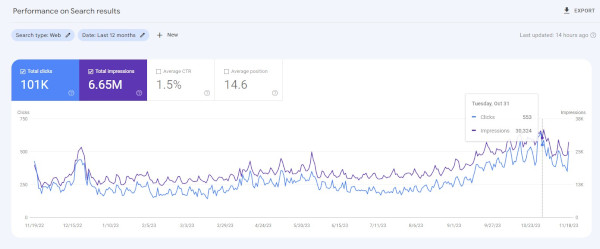Small businesses fight an uphill battle when trying to attract new customers online. Fortunately, methods still exist for the little guy to achieve success in the big world of cyberspace. Chief among those is the art and science of SEO content writing.
The SEO in SEO content writing stands for “search engine optimization.” Search engines like Google present tantalizing opportunities for getting new eyes on your company’s offerings. After all, 81% of Internet users search for products and services on Google every day.
Businesses that optimize their web pages to show up at the top of those search results bring in a lion’s share of that traffic. But how do companies do this? Moreover, is it even possible to climb to the top of search engine results pages (SERPs) when established businesses are already there and seem to have the market cornered?
The answer is yes! However, accomplishing this takes patience, strategy and a lot of high-quality, search engine-optimized content.
This guide will walk you through everything it takes to write content that performs well on Google and other search engines. By the end, you’ll be well-equipped to start writing for SEO optimization on your website.
Of course, if you don’t fancy yourself a writer and don’t have one on your staff, we can help you with that too. Frontier Marketing’s team of expert content writers crafts SEO content for small businesses like yours every day. You can learn more about our SEO services below.
Table of Contents
Here’s an overview of the topics we cover in this guide:
- What is SEO Content Writing?
- Why is Content Important for SEO?
- What are the Benefits of SEO Content Writing?
- How Do You Write SEO Content for a Website?
- What are Content Writing Tips for SEO?
- How Do You Measure the Success of Your Content?
Now, without further ado, let’s get writing!
What is SEO Content Writing?
SEO content writing involves strategically composing information on a web page to make it rank first on SERPs. Ideally, this will bring more traffic to your website and will translate into more customers for your business.
A lot goes into creating content that will perform in this way. It starts with carefully choosing the topics you will cover in your content through keyword research. This process involves identifying the search queries related to your industry that most people are using.
Once you know what your audience is searching for, the next step is to craft helpful and in-depth answers to their questions. These answers can come in several different content formats, including:
- Blogs – Articles providing detailed answers to search queries.
- Infographics – Large graphics featuring charts, diagrams and text about specific topics.
- Pillar Pages – Long-form blogs (e.g., the article you’re currently reading) providing comprehensive overviews of a subject.
- Product or Service Pages – Web pages providing valuable information about products or services a company offers.
- eBooks – Downloadable multi-page documents featuring in-depth information about a topic.
No matter which content format you choose, you need to carefully structure your content to make it easy to read for both people and search engines. Search engines like Google have several criteria they use when determining where to rank a web page in their SERPs. Structuring your content well will send the right signals to Google and make it rank.
Of course, ranking first on Google is only half the battle. It won’t matter how many people click through and read your content if that traffic doesn’t translate into sales for your business. For this reason, SEO writing also involves creating content that persuades people to take a desired action.

Why is Content Important for SEO?
“Does content really need to be well written and helpful to rank on Google? Isn’t it enough to use a popular keyword multiple times in a few hundred words of text?”
Many business owners ask these questions, and we understand why. Writing high-quality content takes a lot of time and energy, and it’s tempting to look for a shortcut.
But we can assure you that writing in-depth content is extremely necessary. This is because Google now considers quality content its top ranking factor for web pages. So, if your content isn’t helpful, thorough and relevant to the targeted search query, then Google won’t promote it to the top of its SERPs.
The Value of High-Quality Content
It wasn’t always this way. Back in the early days of the Internet, websites were able to use techniques like the ones described in the questions above. People would stuff their pages full of keywords and catapult up Google’s rankings even though their pages weren’t helpful and useful at all. Fortunately, Google and other search engines got smart to this practice and substantially improved their ranking factors.
But even if you could still use shortcuts to get thin content to the top of Google, it wouldn’t be a winning strategy. After all, Google isn’t the one who will ultimately decide whether to buy from your business. That power belongs to the people who click through to your page. Do you think those people will be more or less likely to purchase from you if they find your content to be shallow and unhelpful?
Better Content = More Customers
SEO content writing is a quid pro quo marketing strategy. It’s based on the theory that people are more likely to purchase from a brand when that brand gives them valuable content for free. And this theory isn’t without merit. According to a recent study, consumers are 131% more likely to buy from a company that provides them with informative content!
Results like this make sense when you think about the message high-quality content sends to potential customers. It tells them they can trust your business to provide dependable products and services since you already gave them such great value for free! We can’t think of a better foot-in-the-door technique for winning loyal customers and raving fans of your brand.
What are the Benefits of SEO Content Writing?
SEO content writing will make a sizable difference for your business in several ways. The most obvious reason content marketing is important is that it improves your performance on search engines. When you have quality content sitting on top of Google SERPs, you reap these wonderful benefits:
Increase Brand Awareness
People will start to notice when your brand shows up again and again for search queries related to your industry. This name recognition goes a long way when the time comes to make purchasing decisions.
Become an Industry Authority
SEO writing is a great way to demonstrate your industry-relevant knowledge and skills. You can set yourself and your business apart by sharing valuable insights you’ve gained from running your business. Readers will appreciate learning from your years of experience and will be more willing to trust your business for their needs.
Gain a Competitive Edge
Here’s the thing about SEO content writing: most companies don’t do it. So, you will gain a major advantage over many of your competitors if you start doing it now!
We’ve seen many of our clients enjoy the fruit of this benefit. For example, we have clients in the firewood industry who now dominate the SERPs. Few of their competitors were writing blogs about firewood-related topics. So, not long after we started publishing monthly long-form content for them, they were ranking number one for multiple popular keywords in their local regions!
Enjoy Affordable Results
Publishing quality content is the most affordable way to climb up Google’s SERPs. The alternative way is to use paid ads, which is quicker and yields great short-term results. But quality content is an incredibly effective long-term strategy, which brings in more traffic over time without you having to pay anything.

How Do You Write SEO Content for a Website?
Creating quality SEO content requires careful research and planning before you start writing. So, resist the temptation to start writing right away without a strategy.
Instead, take the time to figure out what your audience is searching for, what you’ve already written and what your competitors are doing. Then, based on these insights, create a plan for what content you will create and when.
We’ve put together some more detailed instructions about how to complete each of these steps below. Once you’ve completed these steps, you will be ready to write each piece of content for your website. Tips for doing that can be found in the next section.
Perform Keyword Research
Every good SEO content writing strategy begins with thorough keyword research. This step’s goal is to identify which search queries you would like your website to rank for.
One important principle to keep in mind during keyword research is that the most popular keywords aren’t always the best ones to target. Often, the SERPs for these phrases have multiple high-authority sites dominating the top spots, making it difficult for new content to rank. You can try to dethrone these sites, but it will take a lot of work, and there’s no guarantee you’ll succeed.
A wiser strategy is to target keywords that aren’t quite as popular but still valuable and easier to compete for. For example, instead of going after a massively popular term like “water filter,” consider going after “home water filtration system.” The latter still gets a lot of searches but is less competitive for a more realistic chance of ranking.
Popular Keyword Research Tools
The best way to identify these keywords is with a keyword research tool. Many good ones are available, but we at Frontier Marketing prefer KWFinder from Mangools and Ubersuggest from Neil Patel. These tools allow you to search for keywords and sort them by the number of searches they receive and how difficult it will be to compete for them. You can also save keyword lists and export them as Excel files for your records.
How to Make Keyword Lists
If you’re not sure where to start with your keyword research, we recommend making a list of the products and services you offer. Then search for those products and services in your keyword research tool and create keyword lists for each.
As you do this, remember to also keep search intent in mind. Ask yourself what type of answer a searcher intends to find when searching for each keyword you come across. Sometimes a keyword may look promising but have an intent that’s irrelevant to your business.
A good way to determine the search intent is to look at the top results on the SERP for that term. What types of answers are those results providing? If they’re not in line with the type of solution your company provides, then you’ll want to discard that keyword and focus on other more relevant phrases.
Evaluate Your Current Content
Unless you’re starting from scratch, you probably already have some content on your website. You’re going to want to evaluate the quality of that content and decide what to do with it before you write anything new.
How to Assess Content Quality and Performance
There are two steps to evaluating old content. First, read the content and assess its quality by asking yourself the following questions:
- Is the topic of this content still relevant to my business?
- Is the content shallow and unhelpful or in-depth and valuable?
- Does it contain any outdated or incorrect information?
- Would this page be a good fit for any of the keywords I found in my keyword research?
If the content is low-quality, outdated and irrelevant to your business, then you may want to delete it from your site. However, some low-quality and outdated content may be worth saving and updating.
You can determine if a post is worth saving by using a tool called Google Search Console. This easy-to-navigate analytics platform from Google gives you a clear picture of how each page on your website is performing, showing key metrics like impressions, clicks and click-through rate (CTR). A page that’s worth saving will average thousands of impressions per month with a CTR of at least 1-2%. You’re better off deleting pages that get minimal traffic.

How to Update Old Content
The practice of updating old content is called historical optimization. Some of the best historical optimization techniques to inject new life into your content include:
- Improving readability
- Optimizing it for valuable keywords
- Correcting outdated information
- Fixing broken links
- Enhancing images
- Adding an editor’s note
Keep in mind that if you update the URL of a blog, you should set up a redirect from the old URL to the new one. The same goes for if you combine two old blogs into one new one. Any new URLs you create need redirects created from the old, deleted ones.
Review Your Competitors’ Content
Don’t ignore your competitors during your initial research. Instead, take some time to look at their websites and see what types of content they’ve created. Note what topics they have covered and—more importantly—what they haven’t. This will give you ideas for types of content you can create to outdo them as you plan your content strategy.
Create a Content Strategy
Once you’ve completed your research, the next step is to create an organized plan of attack for content creation. This step is essential for mapping out how each piece of content will fit in the orderly structure of your website.
Your website needs an organized content structure for two reasons:
- It makes it easier for search engines to find, understand and rank your content.
- Visitors will have an easier time finding what they need on your website.
For these reasons, Google values a neat and logical site structure as one of its most important ranking factors.
How to Organize Your Strategy
So, what should an organized content strategy look like? The answer is a simple, three-level hierarchy starting with the main pages of your website and branching out to your pillar pages, blogs and infographics.
The main pages on your website are the ones featured on your top navigation menu (i.e., your home, about and service pages). You want to drive the most traffic to these pages, so you need to optimize them for your most valuable keywords. Therefore, your strategy should include optimizing any main pages that need to be updated.
The next level of the hierarchy is your pillar pages. These long-form blogs should be comprehensive guides on topics related to your business. A good rule of thumb is to have one pillar page related to each of the main product or service pages on your website. For example, a custom aquarium designer might have a service page featuring an overview of what their design service includes and link that page to a pillar page covering everything people need to know about custom aquarium design.
The third level of the hierarchy includes groups of blogs and infographics known as topic clusters. Each of these articles covers a subtopic related to one of the main topics covered in your pillar pages. You can determine which subtopics to cover in your blogs and infographics based on your keyword research. You should assign each article one of the keywords you want to rank for and then optimize the content for that keyword when you write it.
How to Internally Link Your Content
This hierarchy needs to have a consistent internal linking structure to make it easy for search engines and visitors to navigate it. Main service and product pages should link to the pillar pages on their respective topics. Each pillar page should contain a link back to its product/service page and links to all the articles in the topic cluster related to it. Finally, all the individual blogs and infographics should link back to their respective pillar pages.
By taking the time to map out this logical hierarchy, you will set your content up for search engine success.
Create a Content Calendar
The final step of preparation is to determine when you will create each piece of content from your strategy. Obviously, you can’t write everything all at once, so a calendar will help you set realistic expectations for getting everything done.
How you order your content creation schedule is up to you. However, we recommend starting with updating any existing content you have first before creating any new content. We’d start with improving the main pages on your website before moving on to pillar pages, blogs and infographics.
Once you start blogging, keep in mind that Google tends to favor websites that post consistently—whether it be one post per month or one post per week. Visitors also notice when you regularly update your blog and will likely view your company more favorably for it.
We hope this part of the guide has helped you create a solid plan for your content. Nothing fills a writer with confidence like a robust content strategy! So, let’s proceed boldly to SEO content writing tips for each piece of content.
What are Content Writing Tips for SEO?
A lot goes into writing for SEO optimization, but the most important thing to remember is that you’re writing for real people. You can’t trick Google into thinking people will find your content valuable when it isn’t. So, you might as well craft content that speaks directly to your audience’s needs.
Here are some basic content writing tips for how to do it in a Google-approved way:
Write Long-Form Content
If you want to give your content the best shot at ranking, then you need to include at least 1,000 words of valuable information. Notice we didn’t say “any 1,000 words.” Rather, the 1,000+ words must supply the reader with helpful information related to the topic of the page.
Don’t let the monumental task of writing thousands of words overwhelm you. It helps to break each page down into smaller sections and do additional research to fortify your piece.
For example, you can expand a service page by adding an FAQ section featuring helpful answers to common questions about the service. You can also lengthen blogs by adding sections on subtopics related to the main topic and then linking to full articles on those subjects.
Make Headlines Accurate and Engaging
The headline is the most important part of a page because readers use it to decide whether they’ll keep reading or click away. Therefore, you need to take the time to craft a headline that will make your reader want to read more.
The most effective headlines have these two qualities:
- They make it clear exactly what the page is about.
- They hook the reader with an enticing promise of value.
Your headline is not the place to get cute with clever wordplay because it may obscure the topic of the page. Instead, it’s better to plainly spell out what the page covers. And make sure you don’t promise anything in your headline that you don’t deliver in your content. This practice is called clickbait, and Google hates it.
A great tool that helps with crafting accurate and engaging headlines is the Headline Studio from CoSchedule. This tool evaluates your headlines for multiple criteria and provides a score to tell you how effective your title is.
Use Keywords Strategically
Speaking of optimizing your headline, one essential SEO best practice is to include the target keyword for the page in your headline. You should also include it in the page’s SEO title, the meta description and throughout the content.
You may be wondering how many times to use the keyword you’re targeting in your content. According to HubSpot, a good keyword density is 1%, which translates to using the keyword once per every 100 words of copy. However, this is not a hard fast rule. So, don’t obsess over getting the keyword in there that frequently.
A better rule of thumb is to use your keyword naturally in your content and avoid including it just for the sake of including it. This disapproved practice is called keyword stuffing.
It’s also a good idea to incorporate keywords related to your main keyword in your content. These “secondary keywords” help your content rank for the main keyword by showing Google that your content covers all aspects of a topic. An example of this is including the secondary keyword “content writing tips for SEO” in a pillar page with the focus keyword “SEO content writing.”
You should also keep in mind that it’s more valuable to include keywords in headings than in the paragraph content. So, incorporate your primary and secondary keywords into headings when it makes sense to do so.
Write Descriptive Headings and Subheadings
The headings and subheadings you use go a long way in making your content user-friendly. People rarely read website content like they do a book or a magazine. Instead, they quickly skim it to try to glean the info they’re looking for. Your headings and subheadings should make this skimming process easy by precisely describing what the paragraphs beneath them are about.
Link Internally and Externally
As we mentioned above, the content on your page needs to include internal links to the other related pages on your website. A best practice is to create these links on text that either matches or closely relates to the keyword of the page you’re linking to. Doing this can help improve the keyword ranking of that page.
It’s also important to include external links to authoritative sources that support the assertions you make on your page. These links send signals to Google that your content is well-researched and reliable.
Prioritize Readability
Your content shouldn’t be overly difficult to read, or else it will drive away your readers. A good rule of thumb is to write content at an eighth-grade reading level. This way, you will keep your content accessible to a broader audience.
Some rules to follow for keeping your content easy to read include:
- Keeping the number of passive sentences to a minimum.
- Eliminating unnecessary jargon and defining all unfamiliar terms with simple language.
- Breaking up run-on sentences and balancing out longer sentences with shorter ones.
- Using bulleted and numbered lists to break up long paragraphs of text.
Use AI, But Don’t Abuse It
You may have heard about the growing popularity of using Artificial Intelligence (AI) tools like ChatGPT to create content. These tools are certainly impressive and can help save a lot of time during the content creation process. However, we would caution you against making ChatGPT your full-time content writer.
Google has come out and emphatically stated that AI-generated content is against its SEO guidelines. This is because the content AI generates on its own tends to be spammy, duplicative and riddled with inaccuracies. These qualities fly in the face of everything Google is trying to accomplish through its quality content algorithm.
However, this is not to say that you shouldn’t use AI writing tools to help create your content. On the contrary, ChatGPT can help speed up your writing process in many ways, including:
- Content topic brainstorming
- Finding research resources
- Blog outline creation
- Writing first drafts
- Revising text to make it more concise
These are just some of the many ways AI can assist you as you write. But we want to emphasize the word “assist.” Everything you generate using AI needs scrutiny because it isn’t always the most accurate or best quality. So, make sure you always review and fact-check the AI before you use anything it generates in your writing.
Incorporate Visuals
Your web page probably won’t perform as well as it could if it’s just a bunch of text. Therefore, it’s always a good idea to include photos and videos along with your content to make your page more helpful and engaging.
Don’t just think of your visuals as decoration. The photos and videos you choose should enhance your written content by helping readers to better understand what you mean. For example, a roofing company describing an unusual type of shingle in a blog would want to include a photo of that shingle along with the text.
How Do You Measure the Success of Your Content?
An SEO blog writing project doesn’t end once you hit publish. Rather, you need to monitor the performance of the post once you publish it to evaluate if it was a success or not. If the post does not perform well, then you’ll want to update it to improve its performance.
When to Measure Content Success
Keep in mind that organic SEO content rarely starts getting hundreds of clicks overnight. Instead, it typically takes at least six months to reach its full performance potential.
You can help this process along by requesting that Google index your page using the URL Inspection Tool on Google Search Console. But content still typically takes a few months to pick up steam even after Google indexes it.
Therefore, we recommend waiting a year after publishing before you decide whether to update a page. A year of data will give you a clear picture of what Google and your readers think of your content.
How to Measure Content Success
Three content analytics tools we recommend for this analysis are Google Analytics, Google Search Console and Ubersuggest. Here are the key metrics to pay attention to as you use these platforms to evaluate a web page:
- Impressions – The number of times people have viewed a link to your page on SERPs (view on Google Search Console).
- Clicks – The number of times people clicked a link to your content in search results (view on Google Search Console).
- Click Through Rate (CTR) – Total clicks divided by total impressions (view on Google Search Console).
- Average Session Duration – How long a user typically interacts with your page (view on Google Analytics).
- Bounce Rate – The percentage of page visits that resulted in the user leaving without engaging with the content (view on Google Analytics).
- Session Conversion Rate – The percentage of page visits that resulted in some type of conversion (view on Google Analytics).
- Local Rank Tracking – Search engine ranking position for tracked keywords in your local region (view on Ubersuggest).
We recommend looking at the analytics for a page in the order listed above. The first three Google Search Console metrics will tell you if your page is generating enough traffic from Google. A CTR of less than 1% indicates the content needs updating to improve its search performance.
The next three metrics from Google Analytics reveal what visitors think of your content once they start reading it. If the Average Session Duration is low and the Bounce Rate is high, then they aren’t satisfied with the quality of the content. However, if the opposite is true and the content has a high Session Conversion Rate, then your content is doing its job.
We like the Local Rank Tracking tool from Ubersuggest because it clarifies how your SEO writing efforts are working in your local region. It allows you to monitor the keywords you’re targeting and see what position you’re ranking in for each one in cities and metro regions around you.
Need Help with SEO Writing for Your Business?
As you can see, SEO content writing is an essential part of a healthy digital marketing strategy. Your website needs quality content if you want to bring in new traffic from search engines. And the only way to create quality content is through carefully strategizing and following SEO best practices. You also need to monitor the performance of your content after publishing to make sure it succeeds.
If this sounds like a lot of work, don’t let it stress you out. You don’t have to shoulder the burden of content marketing on your own. Instead, let our team of experienced content writers handle it for you.
At Frontier Marketing, we create robust, high-performing SEO content for our clients every day. We do everything from blogs and infographics to comprehensive pillar pages and eBooks. Please call 847-254-0837 or click the button below to learn more about our SEO writing services. We serve clients in our local Fox Lake, IL, the greater Chicago region and throughout the country.



